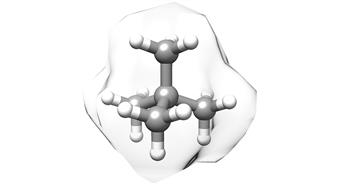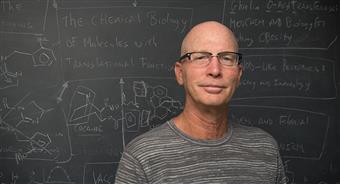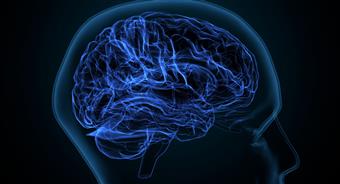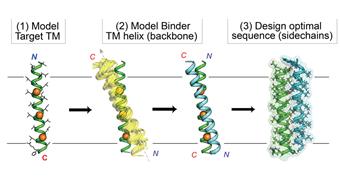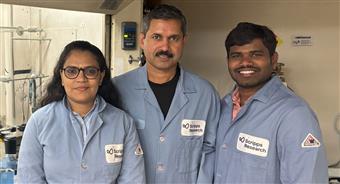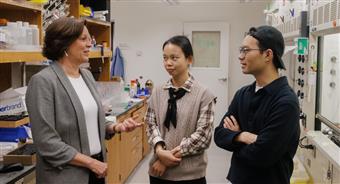
Researchers unveil promising hepatitis C vaccine design The new approach to vaccine design may also prove useful in developing a potential vaccine against the SARS-CoV-2 virus, which causes COVID-19.
April 15, 2020
LA JOLLA, CA A new design for a vaccine against hepatitis C virus (HCV) has shown promise in early tests, according to a study from scientists at Scripps Research.
The scientists, who present their results on April 15 in Science Advances, designed an immune-stimulating particle that resembles a whole virus and is studded with modified versions of an HCV envelope protein. Mice inoculated with these virus-mimicking particles showed a stronger antibody response than when inoculated with HCV proteins on their own. The antibody response was able to block the infectivity of several other HCV strains.
This is a proof of concept study that we hope will soon be followed by further updates and tests to bring us closer to possible clinical trials, says study senior author Jiang Zhu, PhD, an associate professor in the Department of Integrative Structural and Computational Biology at Scripps Research.
The study was a collaboration among three Scripps Research labs: Zhu's; the lab of Mansun Law, PhD, associate professor in the Department of Immunology and Microbiology; and the lab of Ian Wilson, DPhil, Hansen Professor of Structural Biology and Chair of the Department of Integrative Structural and Computational Biology.
Confronting an ongoing global health challenge
HCV is thought to have emerged at least hundreds of years ago as a human pathogen after jumping from another mammal possibly chimpanzees, which also can be infected by the virus. HCV infects the liver and is transmitted mostly via blood exchange; about 80 percent of infections become chronic and typically end in liver cancer or liver failure. Because the infections are often silent, an estimated one-half of people with the disease may not know they're infected, according to the Centers for Disease Control and Prevention.
Globalization and the emergence of practices such as blood transfusions and needle-sharing by drug users have made HCV a significant public health threat. Researchers estimate that roughly 150 million people worldwide have the infection, with large concentrations in Africa and Asia, and that it accounts for at least several hundred thousand liver-disease-related deaths annually.
Treatments for HCV have been developed. But current options are expensive, and typically aren't used until late in the course of infection when severe liver damage has already occurred. HCV also has the potential to evolve to become resistant to drug treatments. Vaccines have been developed against HCV, but so far none has emerged successfully from clinical trials.
HCV is, somewhat like HIV and influenza viruses, a wily pathogen that evades the immune response in part by mutating rapidly. Still, about 20 percent of people who are infected manage to clear the infection on their own, which suggests that the human immune system has some ability to fight off HCV an ability that a vaccine might be able to boost greatly.
Crafty vaccine design for a crafty pathogen
The vaccine design from Zhu and his team centers on HCV's E2 protein. E2, in partnership with a smaller protein called E1, forms spike-like structures that stud the surface of each virus particle. E2 is the subunit of these spikes that binds to receptors on liver cells, and is the HCV protein most targeted by the immune response.
The Scripps Research team used a modified version of E2 that stabilizes its structure and omits the highly variable outer portions, leaving just the core portions that tend not to vary much from strain to strain because they're needed for the virus's efficient entry into cells.
The idea is to remove all the distracting parts of E2 and display to the immune system only those essential structural elements where antibodies can attach to neutralize different strains, Zhu says.
The team developed a method to mount dozens of copies of the engineered E2 proteins onto a self-assembling protein nanoparticle so that each of these completed creations would feel, to the immune system, more like a real virus particle.
Injected into mice, the E2-covered nanoparticles elicited stronger antibody responses than E2 proteins alone. Antibodies harvested from the mice neutralized, in lab-dish tests, HCV from two widely different groupings, or genotypes, of the virus.
The next step, Zhu says, is to create a polyvalent vaccine design that can confer protection against essentially all the different forms of HCV. It will use nanoparticles with E2 cores that are representative of the six major HCV genotypes. A prototype could be ready for testing in primates or even humans in a year or so, he adds.
Zhu and his team in 2018 accomplished a similar nanoparticle-based design for a vaccine against HIV. The researchers are following the same approach to develop vaccines against SARS-CoV-2, which causes COVID-19, and Ebolavirus, which causes viral hemorrhagic fever.
This approach provides us with basic vaccine templates that we can relatively rapidly turn into prototype vaccines for testing, Zhu says.
Proof-of-concept for rational design of hepatitis C virus E2 core nanoparticle vaccines was written by co-first authors Linling He and Netanel Tzarum; Xiaohe Lin, Benjamin Shapero, Cindy Sou, Colin Mann, Armando Stano, Lei Zhang, Kenna Nagy, Erick Giang, Mansun Law, Ian Wilson, and Jiang Zhu, all of Scripps Research.
Funding was provided by the National Institutes of Health (P01 AI124337, AI129698, AI140844, AI123861, AI079031, AI123365 and AI106005) and by Ufovax LLC, a spin-off vaccine company of Scripps Research, who holds exclusive rights to develop and commercialize the Scripps Research nanoparticle vaccine technology (1c-SApN
More from Scripps
12/04/2024
Scripps Research chemists devise easier new method for making a common type of building block for drugs Scientists transform simple linear amines into saturated...
06/04/2024
A simple, inexpensive way to make carbon atoms bind together A Scripps Research team uncovers a cost-effective method for producing quaternary carbon molecules,...
04/04/2024
Developing a vaccine for the zombie drug xylazine Scripps Research chemical biologists design an early proof-of-concept vaccine that could lead to the first...
30/03/2024
How blocking a neural receptor responsible for addiction could reduce alcohol use A Scripps Research team found that a new therapeutic that targets the kappa op...
13/03/2024
New computational strategy boosts the ability of drug designers to target proteins inside the membrane Customized-design approach could streamline the design of...
29/02/2024
Scripps Research scientists reveal how first cells could have formed on Earth New phospholipid discovery brings researchers closer to understanding how primordi...
29/02/2024
How molecular handedness emerged in early biology Scripps Research chemists fill a major gap in origin-of-life theories.
February 28, 2024
LA JOLLA, CA Mole...
22/02/2024
Snaking toward a universal antivenom Scripps Research scientists discovered antibodies that protect against a host of lethal snake venoms.
February 21, 2024
...
06/02/2024
Calibr-Skaggs announces expansion of option and license agreement with AbbVie to develop novel cell therapies for solid tumors and autoimmune diseases
AbbVie...
26/01/2024
Re-energizing mitochondria to treat Alzheimer's disease Scripps Research team restored neuron-to-neuron connections in human cells.
January 25, 2024
LA JO...
24/01/2024
100 years of Science Changing Life: Scripps Research celebrates a century of transforming human health For the last century, institute leaders and renowned scie...
23/01/2024
New technology lets researchers track brain cells' off switches The method could shed light on what goes awry in numerous brain conditions when neurons ar...
09/01/2024
Three decades of giving: Announcing the Calibr-Skaggs Institute for Innovative Medicines The ALSAM Foundation, founded by the Skaggs family, provides lasting g...
04/01/2024
Life science entrepreneur Gene Lay joins Scripps Research Board of Directors Lay, founder of the global biotech company BioLegend, brings invaluable experience ...
21/12/2023
Taming a plant-derived toxin Scripps Research team modifies the traditional poison picrotoxinin for potential neurological drugs and anti-parasite treatments. ...
19/12/2023
Scripps Research Executive Vice President Eric Topol gives TED talk on transformative power of AI in medicine Topol provides an overview of how AI models can i...
13/12/2023
New AI-powered algorithm could better assess people's risk of common heart condition Early detection of atrial fibrillation can reduce the risk of stroke an...
07/12/2023
Nanoparticle flu vaccine design shows promise in early tests Scripps Research-designed vaccine could provide broad, enduring protection against influenza A str...
16/11/2023
Numerous Scripps Research scientists named Highly Cited Researchers Clarivate's annual, global list represents researchers who have demonstrated significant...
07/11/2023
Multiple sclerosis drug invented at Scripps Research slows long-term devastating disease progression Late-breaking data reinforces the effectiveness and safety ...
05/10/2023
Keren Lasker named a 2023 Moore Inventor Fellow The prestigious award will support Lasker's inventive research in membraneless organelles and their applica...
22/09/2023
Michael Bollong named a 2023 Amgen Young Investigator The prestigious award will support Bollong's research identifying new molecular targets and therapeuti...
09/09/2023
Philip Dawson receives 2024 American Chemical Society National Award Dawson is honored with the Arthur C. Cope Late Careers Scholar Award for his foundational c...
07/09/2023
Scripps Research chemists devise a method for C-H activation of alcohols The method represents a new toolkit for making drugs and other compounds.
September 06...
31/08/2023
Scripps Research receives $1.5M to surveil infectious disease threats in wastewater Bill & Melinda Gates Foundation award to support the development of multi-pa...
16/08/2023
How cold temperatures trigger the brain to boost appetite Scripps Research scientists' discovery could lead to new weight loss and metabolic health treatmen...
08/08/2023
Human antibody that targets carfentanil, fentanyl and related opioids reverses overdose effects in preclinical study Scripps Research-developed antibody therapy...
04/08/2023
How sensory neurons impact the gut Scripps Research scientists show that the receptor PIEZO2 in sensory neurons controls gut motility and transit time, which a...
26/07/2023
AbbVie and Calibr Expand Strategic Collaboration to Advance Several Preclinical and Early-stage Clinical Assets The expanded strategic collaboration will advan...
23/07/2023
Scripps Research scientists develop AI-based tracking and early-warning system for viral pandemics Machine-learning system effectively predicts emergence of pro...
19/07/2023
Monitoring T cells may allow prevention of type 1 diabetes Scripps Research study shows that analyzing T cells in blood samples could be used to select at-risk ...
19/07/2023
Scripps Research mourns passing of leading organic chemist Albert Eschenmoser Eschenmoser pioneered key reactions in synthetic chemistry and shaped the understa...
15/06/2023
Scripps Research awarded $46.8 million by NIH to promote human health through innovative translational science and training The Translational Institute is harne...
13/06/2023
Scripps Research's Danielle Grotjahn named 2023 Pew Scholar in the Biomedical Sciences The award will support Grotjahn's study of how cells assemble the...
31/05/2023
Crossing the ring: new method enables C-H activation across saturated carbocycles Scripps Research chemists add another powerful tool to their molecular editin...
24/05/2023
Scripps Research develops behind-the-scenes tool for better biomedical data discovery The new resource makes datasets more discoverable for life science communi...
19/05/2023
Scripps Research neuroscientist Hollis Cline elected to American Academy of Arts and Sciences Cline is recognized for her discoveries about the role of sensory ...
19/05/2023
Scripps Research's Skaggs Graduate School awards doctoral degrees to 31st graduating class Commencement ceremony will be livestreamed via Zoom and on instit...
13/05/2023
A better route to benzocyclobutenes, sought-after building blocks for drugs Scripps Research chemists devise a new, C-H activation-based method for the synthesi...
09/05/2023
Renowned Scripps Research professor Jeffery Kelly elected to National Academy of Sciences Kelly's groundbreaking work on protein misfolding has led to thera...
28/04/2023
Mirror-image molecules pave new path for cancer drug discovery By comparing how mirror image versions of small molecules impact clusters of proteins, Scripps R...
22/04/2023
How alcohol consumption contributes to chronic pain A Scripps Research team showed how both alcohol intake and alcohol withdrawal can lead to increased pain and...
21/04/2023
Xin Jin receives dual awards to study autism risk genes in neurodevelopment Major grants from the National Institutes of Health and California Institute for Reg...
20/04/2023
Trim the sugar: New HIV vaccine design improves immune response Scripps Research vaccine candidate headed for clinical trials.
April 19, 2023
LA JOLLA, CA A...
18/04/2023
Therapeutic can seek and destroy potent opioid to treat overdoses Scripps Research chemists developed a new biologic to work against the synthetic opioid carfen...
07/03/2023
How heavy alcohol consumption increases brain inflammation The findings by a Scripps Research team point toward a potential new drug target for treating alcohol...
02/03/2023
Scientists find human antibodies that can block multiple coronaviruses including SARS-CoV-2 Results from a Scripps Research and UNC team pave the way for a vacc...
28/02/2023
$10 million grant funds Scripps Research Alcohol Research Center through its 50th year The five-year grant supports research into the neurobiology of alcohol us...
28/02/2023
Immune system drug shows promise in treating alcohol use disorder, a Scripps Research clinical trial reports Scientists at Scripps Research found that apremilas...
23/02/2023
Chemically poisoned protein acts as a molecular switch to spur cancer formation The discovery triggered development of a new potential drug to eliminate tumor...
 Researchers unveil promising hepatitis C vaccine design The new approach to vaccine design may also prove useful in developing a potential vaccine against the SARS-CoV-2 virus, which causes COVID-19.
Researchers unveil promising hepatitis C vaccine design The new approach to vaccine design may also prove useful in developing a potential vaccine against the SARS-CoV-2 virus, which causes COVID-19. 














